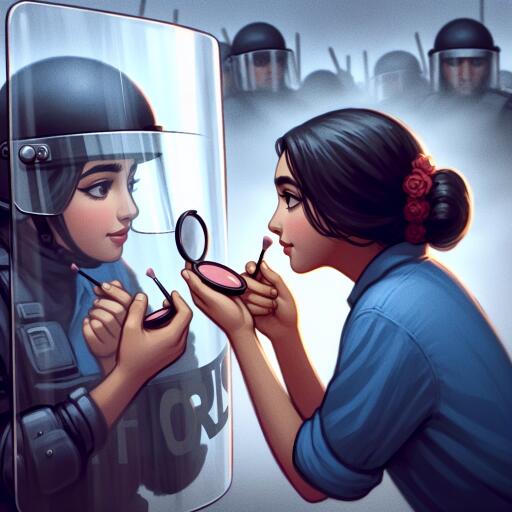Debunking the Viral Image: The True Story Behind the Woman and the Riot Shield
In a world where information travels faster than light, the story behind a single photograph can ignite discussions and fuel narratives. Recently, an image captured the internet’s collective imagination—a woman applying makeup in the gleaming surface of a police riot shield. This act, interpreted by many as a brazen defiance against oppressive forces, quickly became a symbol of protest. However, the true context of this photo reveals much more than meets the eye, emphasizing the importance of accuracy in our quest for symbols of resistance.
While it’s undeniable that the world’s attention has been riveted by various global conflicts and humanitarian crises, notably the distressing events in Israel, each act of protest or defiance holds its unique back story. The woman in the viral photo, far from being associated with the pro-Gaza protests as some have speculated, hails from a different struggle altogether.
The photograph in question was taken not in the heat of the Middle Eastern conflict but in the heart of Europe—in Tbilisi, the vibrant capital city of Georgia. The subject is not an activist rallying for Gaza but a Georgian woman caught in a moment of personal rebellion against her own government’s controversial legislation.
This legislation, known as the Law on Transparency of Foreign Influence, has sparked significant concern and opposition within Georgian society. Pushed forward by the ruling Georgian Dream party, the proposed bill seeks to label organizations, including media outlets receiving over 20% of their funding from abroad, as “agents of foreign influence.” This designation, requiring registration and public declaration, could stigmatize these organizations and deteriorate their relationships with the Georgian public. Critics argue that such a law could pave the way for the government to target and silence dissent, drawing parallels with similar laws in Russia that have been used to suppress political dissent and control the narrative.
The woman’s act of defiance, using a riot shield as a makeshift mirror, serves as a poignant emblem of the broader resistance against governmental overreach and the suppression of free speech. While her actions may not be linked to the protests in support of Gaza, they reflect a universal yearning for freedom and the exercise of individual rights under oppressive regimes.
This episode serves as a vivid reminder of the myriad struggles unfolding around the globe, each with their unique contexts and heroes. As we bear witness to these moments of resistance, let us strive for a deeper understanding beyond the surface level. In doing so, we not only honor the true stories of those who fight against oppression but also ensure that our support and admiration are rooted in reality rather than misinterpretation.
In the end, whether it’s a stand against international conflict or a domestic policy dispute, acts of defiance like that of the Georgian woman’s improvise touch-up resonate universally. They remind us of the resilience of the human spirit in the face of adversity, and the ongoing battle for justice and democracy around the world.








